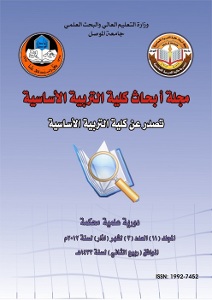Spexin Hormone and Its Relationship With Age, Sex, and Smoking in Heart Attack Patients
Abstract
Study focused on anthropometric measurements in addition to smoking , its relationship with Spexin hormone (SPX) and its role in heart attack risk for both sexes. 91 samples were collected from people with heart attacks and 91 likewise were collected from people to be control group. Outcomes demonstrated that level of hormone decreased with age, while body mass index (BMI) increased with age for group suffering heart attack compared with control group, incidence rate in males is 2.25 times higher than in females, age is a major factor that affects hormone levels and reduces its activity, males of all age groups usually have a higher infection rate than females of the same age groups. In addition, smokers are more susceptible to heart attacks compared to non-smokers.
Finally, this study discovered a connection between a decline in spexin as well as rise in risk factor for heart attack, which has a strong role, especially in male smokers and those who are overweight.
References
- . Alheyali, M.A., & Al-Jawadi, Z. A.M. (2022). Biochemical Effect of Thyroid Hormones on Heart Failure. Egyptian Journal of Chemistry. 65(3): 185-189.
- . Picazo-Angelin, B., Zabala-Argüelles, J. I., Anderson, R. H., & Sánchez-Quintana, D. (2018). Anatomy of the normal fetal heart: The basis for understanding fetal echocardiography. Annals of pediatric cardiology, 11(2): 164–173. https://doi.org/10.4103/apc.APC_152_17.
- . Gaitskell, K., Perera, R., & Soilleux, E. J. (2011). Derivation of new reference tables for human heart weights in light of increasing body mass index. Journal of clinical pathology, 64(4): 358–362. https://doi.org/10.1136/jcp.2010.084574.
- . Sachdeva, P., Kaur, K., Fatima, S., Mahak, F., Noman, M., Siddenthi, S. M., Surksha, M. A., Munir, M., Fatima, F., Sultana, S. S., Varrassi, G., Khatri, M., Kumar, S., Elder, M., & Mohamad, T. (2023). Advancements in Myocardial Infarction Management: Exploring Novel Approaches and Strategies. Cureus, 15(9): e45578. https://doi.org/10.7759/cureus.45578.
- . Lu, L., Liu, M., Sun, R., Zheng, Y., & Zhang, P. (2015). Myocardial Infarction: Symptoms and Treatments. Cell biochemistry and biophysics, 72(3): 865–867. https://doi.org/10.1007/s12013-015-0553-4.
- . Tran, A., He, W., Chen, J. T. C., & Belsham, D. D. (2022). Spexin: Its role, regulation, and therapeutic potential in the hypothalamus. Pharmacology & Therapeutics,233,108033. https://doi.org/10.1016/j.pharmthera.2021.10803
- . Kurowska, P., Dawid, M., Oprocha, J., Respekta, N., Serra, L., Estienne, A., Pawlicki, P., Kotula-Balak, M., Guérif, F., Dupont, J., & Rak, A. (2023). Spexin role in human granulosa cells physiology and PCOS: expression and negative impact on steroidogenesis and proliferation†. Biology of Reproduction, 109(5), 705–719. https://doi.org/10.1093/biolre/ioad10
- . Mirabeau, O., Perlas, E., Severini, C., Audero, E., Gascuel, O., Possenti, R., Birney, E., Rosenthal, N., & Gross, C. (2007). Identification of novel peptide hormones in the human proteome by hidden Markov model screening. Genome Research, 17(3), 320–327. https://doi.org/10.1101/gr.5755407
- . Wong, M. K. H., He, M., Sze, K. H., Huang, T., Ko, W. K. W., Bian, Z. X., & Wong, A. O. L. (2021). Mouse Spexin: (I) NMR Solution Structure, Docking Models for Receptor Binding, and Histological Expression at Tissue Level. Frontiers in Endocrinology, 12. https://doi.org/10.3389/fendo.2021.681646
- . Darakci Saltik, Ö., & Bozkurt, A. (2022). Structure and functions of spexin as a new neuroendocrine signal. In Journal of Experimental and Clinical Medicine (Turkey) (Vol. 39, Issue 3, pp. 893–900). Ondokuz Mayis Universitesi. https://doi.org/10.52142/omujecm.39.3.56
- . Jeong, B., Kim, K. K., Lee, T. H., Kim, H. R., Park, B. S., Park, J. W., Jeong, J. K., Seong, J. Y., & Lee, B. J. (2022). Spexin Regulates Hypothalamic Leptin Action on Feeding Behavior. Biomolecules, 12(2): 236. https://doi.org/10.3390/biom12020236.
- . Lin, C. Y., Huang, T., Zhao, L., Zhong, L. L. D., Lam, W. C., Fan, B. M., & Bian, Z. X. (2018). Circulating Spexin Levels Negatively Correlate With Age, BMI, Fasting Glucose, and Triglycerides in Healthy Adult Women. Journal of the Endocrine Society, 2(5): 409–419. https://doi.org/10.1210/js.2018-00020.
- . Schmitt, R., Marlier, A., & Cantley, L. G. (2008). Zag expression during aging suppresses proliferation after kidney injury. Journal of the American Society of Nephrology:JASN,19(12): 375–2383. https://doi.org/10.1681/ASN.2008010035
- . Neuhaus, J. F., Baris, O. R., Kittelmann, A., Becker, K., Rothschild, M. A., & Wiesner, R. J. (2017). Catecholamine Metabolism Induces Mitochondrial DNA Deletions and Leads to Severe Adrenal Degeneration during Aging. Neuroendocrinology, 104(1): 72–84. https://doi.org/10.1159/000444680.
- . Sagris, M., Antonopoulos, A. S., Theofilis, P., Oikonomou, E., Siasos, G., Tsalamandris, S., Antoniades, C., Brilakis, E. S., Kaski, J. C., & Tousoulis, D. (2022). Risk factors profile of young and older patients with myocardial infarction. Cardiovascular research, 118(10): 2281–2292. https://doi.org/10.1093/cvr/cvab264.
- . Jortveit, J., Pripp, A. H., Langørgen, J., & Halvorsen, S. (2020). Incidence, risk factors and outcome of young patients with myocardial infarction. Heart (British Cardiac Society), 106(18): 1420–1426. https://doi.org/10.1136/heartjnl-2019-316067.
- . Canto, J. G., Rogers, W. J., Goldberg, R. J., Peterson, E. D., Wenger, N. K., Vaccarino, V., Kiefe, C. I., Frederick, P. D., Sopko, G., Zheng, Z. J., & NRMI Investigators (2012). Association of age and sex with myocardial infarction symptom presentation and in-hospital mortality. JAMA, 307(8): 813–822. https://doi.org/10.1001/jama.2012.199.
- . Millett, E. R. C., & Peters, S. A. E. (2018). Woodward M. Sex differences in risk factors for myocardial infarction: cohort study of UK Biobank participants. BMJ, 363: k4247. https://doi.org/10.1136/bmj.k4247
- . Mehta, L. S., Beckie, T. M., DeVon, H. A., Grines, C. L., Krumholz, H. M., Johnson, M. N., Lindley, K. J., Vaccarino, V., Wang, T. Y., Watson, K. E., Wenger, N. K., & American Heart Association Cardiovascular Disease in Women and Special Populations Committee of the Council on Clinical Cardiology, Council on Epidemiology and Prevention, Council on Cardiovascular and Stroke Nursing, and Council on Quality of Care and Outcomes Research (2016). Acute Myocardial Infarction in Women: A Scientific Statement From the American Heart Association. Circulation, 133(9): 916–947. https://doi.org/10.1161/CIR.0000000000000351
- . Song, S., Lee, H. A., Kim, Y., Jeon, B. K., Moon, C. M., & Park, J. (2023). Dynamic changing smoking habits and cardiovascular events in patients newly diagnosed with hypertension, diabetes, or dyslipidemia: a national cohort study. Frontiers in cardiovascular medicine, 10, 1190227. https://doi.org/10.3389/fcvm.2023.1190227.
- . Jalali, Z., Khademalhosseini, M., Soltani, N., & Esmaeili Nadimi, A. (2021). Smoking, alcohol and opioids effect on coronary microcirculation: an update overview. BMC cardiovascular disorders, 21(1), 185. https://doi.org/10.1186/s12872-021-01990-y.






